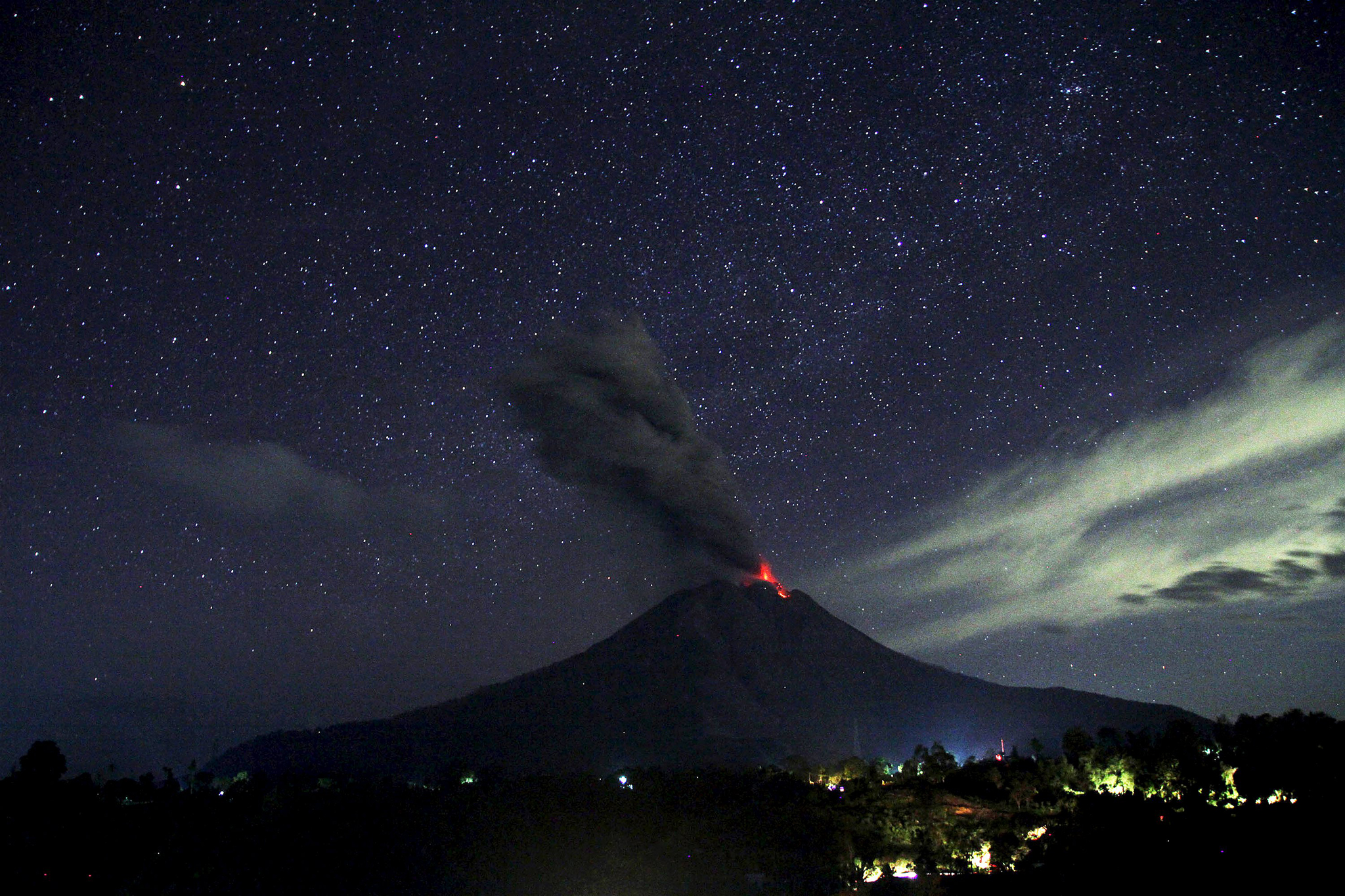.
Western Meadowlark (Sturnella neglec), Malheur National Wildlife Refuge, Oregon.An abundant and familiar bird of open country across the western two-thirds of the continent, the Western Meadowlark is known for its melodic song. It is frequently seen singing along roadsides in native grassland and agricultural areas. Meadowlarks are common along roadsides nearMalheur National Wildlife Refuge in southeast Oregon.: photo by Dan Dzurisin, 15 April 2007
Song birds enter the morning
Songs that even God didn't know,
Western Meadowlark (Sturnella neglec), Malheur National Wildlife Refuge, Oregon.An abundant and familiar bird of open country across the western two-thirds of the continent, the Western Meadowlark is known for its melodic song. It is frequently seen singing along roadsides in native grassland and agricultural areas. Meadowlarks are common along roadsides nearMalheur National Wildlife Refuge in southeast Oregon.: photo by Dan Dzurisin, 15 April 2007
Western Meadowlark (Sturnella neglec), Malheur National Wildlife Refuge, Oregon.An abundant and familiar bird of open country across the western two-thirds of the continent, the Western Meadowlark is known for its melodic song. It is frequently seen singing along roadsides in native grassland and agricultural areas. Meadowlarks are common along roadsides nearMalheur National Wildlife Refuge in southeast Oregon.: photo by Dan Dzurisin, 15 April 2007
White-faced Ibis (Plegadis chihi), Malheur National Wildlife Refuge, Oregon. The White-faced Ibis, a dark wading bird with a long, down-curved bill, breeds across the western United States northward to Montana, eastward to western Louisiana, and southward to South America. Ibis and other shore birds are numerous during spring migrations at Malheur National Wildlife Refuge in southeast Oregon.: photo by Dan Dzurisin, 15 April 2007
Long-billed Curlew, Malheur National Wildlife Refuge, Oregon.North America's largest shore bird, the Long-billed Curlew breeds in the grasslands of the Great Plains and Great Basin. Curlews and other shore birds are numerous during spring migrations at Malheur National Wildlife Refuge in southeast Oregon.: photo by Dan Dzurisin, 15 April 2007
Swamps and people live in a lake
risen from a volcano
An island bolted from fire
appears out of the sea like
A memory appearing in the shadow
of dark yearnings.
Who can appear to me?
Joseph Ceravolo (1934-1988): March 7, 1988, from Collected Poems, 2012
Ekrem Turkmen poses for a portrait in his store selling Ottoman Traditional clothing inside the Istanbul Grand Bazaar in Istanbul, Turkey. Istanbul’s Grand Bazaar is one of the oldest covered markets in the world and hosts more than 3,000 stores. It is estimated that more than 250,000 people visit the bazaar each day : photo by Chris McGrath via FT Photo Diary, 8 January 2016
Image may be NSFW.
Clik here to view.![Shop Keepers And Hundreds Of Years Of Tradition In The Grand Bazaar...ISTANBUL, TURKEY - JANUARY 07: Ekrem Turkmen poses for a portrait in his store selling Ottoman Traditional clothing inside the Istanbul Grand Bazaar on January 7, 2016 in Istanbul, Turkey. Istanbul's Grand Bazaar is one of the oldest covered markets in the world and hosts more than 3,000 stores. It is estimated that more than 250,000 people visit the bazaar each day. Despite an increase in new modern shopping malls, the beauty and tradition of the Grand Bazaar continues to be an advantage, in 2014 it was listed as the world's most visited tourist attraction. (Photo by Chris McGrath/Getty Images)]()
.
Ekrem Turkmen poses for a portrait in his store selling Ottoman Traditional clothing inside the Istanbul Grand Bazaar in Istanbul, Turkey. Istanbul’s Grand Bazaar is one of the oldest covered markets in the world and hosts more than 3,000 stores. It is estimated that more than 250,000 people visit the bazaar each day : photo by Chris McGrath via FT Photo Diary, 8 January 2015
Joseph Ceravolo: January 1988
All the stars will be gone,
there is enough emptiness in space
to absorb all dust of stars,
while you and I speak under voice
of birds, sleep, mist
at the hour of the street.
Nobody is loitering, O sensual eyes
just see or connect the dreamers
and as our generation's blood spills,
the water of night is flooding us.
Nobody's holding anybody's wrist
nobody's humming nobody's singing
in the hour of the street.
Joseph Ceravolo (1934-1988): January 1988, from Collected Poems, 2012
A Yemeni inspects a vehicle destroyed by airstrikes allegedly carried out by the Saudi-led coalition in Sana’a. Airstrikes by the Saudi-led coalition have intensified since the humanitarian ceasefire in Yemen ended: photo by Yahya Arhab/EPA, 8 January 2016
Image may be NSFW.
Clik here to view.![Saudi-led airstrikes on Sana'a...epa05092911 A Yemeni inspects a vehicle destroyed by airstrikes allegedly carried out by the Saudi-led coalition in Sanaía, Yemen, 08 January 2016. Airstrikes by the Saudi-led coalition have intensified since the humanitarian ceasefire in Yemen ended on 02 January. EPA/YAHYA ARHAB]()
A Yemeni inspects a vehicle destroyed by airstrikes allegedly carried out by the Saudi-led coalition in Sana’a. Airstrikes by the Saudi-led coalition have intensified since the humanitarian ceasefire in Yemen ended: photo by Yahya Arhab/EPA, 8 January 2016
Migrants and refugees walk on Friday after crossing the Macedonian border in the Serbian village of Miratovac. Migrants and refugees are facing deteriorating weather conditions as they make their way to the EU via the Balkans: photo by Armend Nimani/AFP 8 January 2016
Image may be NSFW.
Clik here to view.![Migrants and refugees walk on Friday after crossing the Macedonian border in the Serbian village of Miratovac. Migrants and refugees are facing deteriorating weather conditions as they make their way to the EU via the Balkans. Despite cold and heavy rain, thousands of migrants continue to arrive in Serbia. More than a million refugees and migrants arrived in Europe in 2015 in the worst crisis of its kind to face the continent since World War II.]()
Migrants and refugees walk on Friday after crossing the Macedonian border in the Serbian village of Miratovac. Migrants and refugees are facing deteriorating weather conditions as they make their way to the EU via the Balkans: photo by Armend Nimani/AFP 8 January 2016
An Iranian woman holds up a poster showing Sheikh Nimr al-Nimr, a prominent opposition Saudi Shia cleric who was executed last week by Saudi Arabia, in Tehran, Iran: photo by Vahid Salemi/AP, 4 January 2016
Image may be NSFW.
Clik here to view.![Nimr al-Nimr...An Iranian woman holds up a poster showing Sheikh Nimr al-Nimr, a prominent opposition Saudi Shiite cleric who was executed last week by Saudi Arabia, in Tehran, Iran, Monday, Jan. 4, 2016. Allies of Saudi Arabia followed the kingdom's lead and began scaling back diplomatic ties to Iran on Monday after the ransacking of Saudi diplomatic missions in the Islamic Republic, violence sparked by the Saudi execution of al-Nimr. (AP Photo/Vahid Salemi)]()
An Iranian woman holds up a poster showing Sheikh Nimr al-Nimr, a prominent opposition Saudi Shia cleric who was executed last week by Saudi Arabia, in Tehran, Iran: photo by Vahid Salemi/AP, 4 January 2016
Shia Muslims shout slogans during a protest against the execution of cleric Nimr al-Nimr, who was executed along with others in Saudi Arabia, on the outskirts of Srinagar, India on Friday ended: photo by Danish Ismail/Reuters, 8 January 2016
Image may be NSFW.
Clik here to view.![Shia Muslims shout slogans during a protest against the execution of cleric Nimr al-Nimr, who was executed along with others in Saudi Arabia, on the outskirts of Srinagar, India January 8, 2016.]()
Shia Muslims shout slogans during a protest against the execution of cleric Nimr al-Nimr, who was executed along with others in Saudi Arabia, on the outskirts of Srinagar, India on Friday ended: photo by Danish Ismail/Reuters, 8 January 2016
A customer asks for the price of a bittergourd at Duri market on a railway track in Jakarta, on Friday: photo by Beawiharta/Reuters, 8 January 2016
A customer asks for the price of a bittergourd at Duri market on a railway track in Jakarta, on Friday: photo by Beawiharta/Reuters, 8 January 2016
DEVELOPING: #AmmonBundy militia takeover sparked by Hammonds’ “unconstitutional” sentencing: image via RT Verified account @RT_com, 2 January 2015
What will happen if the Oregon militia gets its demands? Kate Galbraith in San Francisco and Sarah Gilman in Portland for The Guardian, 8 January 2016
Allowing cattle to graze across swathes of federal land in Oregon, as an armed band of militia is demanding, could have devastating consequences for the area’s delicate ecosystem, experts have warned.
Rare species such as the greater sage grouse that does a mating dance on federal land adjacent to the Malheur national wildlife refuge, occupied by the militia, have already been harmed by widespread cattle grazing on high-desert plains across the west.
The armed militia is occupying federal land in Oregon that contains swathes of marshland, an unusual feature amid the high desert of southeastern Oregon.
The militia, a ragtag group whose leader, Ammon Bundy, comes from a Nevada family with a history of defying federal land-use rules, has a hazy wish list that includes the release of two Oregon men, imprisoned and convicted of arson. But one of their broadest demands is to transfer more federal land to private ownership in the area.
Such a change could mean a “scorched-earth” situation for wildlife, said Dale Goble, a professor and land-use expert at the University of Idaho’s College of Law, who had gone birding in the refuge.
“If you’ve driven through the high desert of eastern Oregon, the distinction between private and federal [land] is often strikingly clear,” he said. Were the land to be transferred to private ownership, “the marshes and everything that attracts the migratory bird species -- probably, my guess would be, used for irrigation”.
The simmering tension between ranchers and the federal government is nothing new to the American west. The federal government manages enormous chunks of land, a holdover from the days of westward expansion.
In the mid-to-late 20th century, ranchers and other groups began a movement known as the Sagebrush Rebellion to lobby for more federal land to be transferred to state control. That effort continues today, Goble said, in states like Utah and Idaho.
The modern-day rebels have an even more radical wish: to transfer federal lands to private control. How that would happen is unclear, and ordinary ranchers may not have enough money to buy the land in any case, Goble said.
But increased private ownership could have harsh consequences for wildlife across the west, where many plants and animals are already on the federal government’s list of threatened or endangered species.
Dan Morse of the Oregon Natural Desert Association, an environmental group, said that while some species can get by with a network of connected public lands, it’s much harder to protect them when the land is a patchwork of private owners who manage their property mainly for economic gain.
“For me, one of the most concerning notions is the concept that these lands need to be returned to the public,” Morse says. The land, and its benefits, “already are public.”
In Oregon, waves of songbirds, sandhill cranes, long-billed curlews and other waterfowl pass through Malheur, which is a “crown jewel” of the federal refuge system, says Bob Sallinger, conservation director of the Portland Audubon Society. Some 20% of the entire population of white-faced ibises use the refuge’s lakes and waterways, he added.
“Any forage, any grass, any wildflower that cows eat isn’t available for bighorn sheep, deer, elk, pronghorn, sage grouse, butterflies or other native wildlife species,” says Andy Kerr, an environmental consultant who worked on conservation and public land grazing issues near the refuge in the 1990s.
“Twenty percent of all species listed under the Endangered Species Act have livestock as a factor in their decline.”
Image may be NSFW.
Clik here to view.![]()
Rare species such as the greater sage grouse that do a mating dance on federal land adjacent to the Malheur national wildlife refuge, occupied by the militia, have already been harmed by widespread cattle grazing on high-desert plains across the west: photo by Jerret Raffety/AP, 8 January 2016
The Borax Lake chub, an endangered species of fish, is found largely in the Oregon county that contains the refuge.
The federal government’s record on environmental management is far from perfect, but it is considerably better than that of private landowners, Goble said. The US Fish and Wildlife Service, the agency that oversees the refuge, has a clear responsibility to manage its refuges for the sake of wildlife. The service also oversees endangered or threatened species listings, so it has a direct responsibility to protect them.
The Bureau of Land Management, which oversees some 260m acres across the United States, has a less clear-cut connection to threatened wildlife. It has sometimes been known as the “Bureau of Livestock and Mining” because it allows private companies and individuals to use its land for grazing (for a low fee), logging and other extraction activities.
The BLM must consult with the wildlife service over endangered or threatened species on its lands, which should ensure at least some protections. Private landowners do not have to do such consultations, though they are prohibited from killing (or contributing to the killing of) endangered species on their property.
Ranchers across the west have a different view: They see themselves as the best stewards of the land, and the federal government as imposing onerous requirements.
Erin Maupin, a rancher near the refuge who visited the occupation this week, said government wildlife officials had no business controlling the land and have done a poor job of caring for the local environment. “More birds come to our ranches than here,” she said.
Harney County sheriff Dave Ward meets with Ammon Bundy outside the wildlife refuge: photo by Beth Nakamura/AP, 6 January 2015
Albino Dark-crested Cormorant (Phelacrocorax auritus) nestlings, Malheur Lake, Malheur National Wildlife Refuge, Oregon: photo by Jon C. Anderson, 16 May 1972
Blackbird, Burns, Oregon: photo by Austin Granger, 22 April 2014
Song birds enter the morning
Image may be NSFW.
Clik here to view.
Clik here to view.

Western Meadowlark (Sturnella neglec), Malheur National Wildlife Refuge, Oregon.An abundant and familiar bird of open country across the western two-thirds of the continent, the Western Meadowlark is known for its melodic song. It is frequently seen singing along roadsides in native grassland and agricultural areas. Meadowlarks are common along roadsides nearMalheur National Wildlife Refuge in southeast Oregon.: photo by Dan Dzurisin, 15 April 2007
Joseph Ceravolo: March 1988
Song birds enter the morning
the pre-dawn before the fires
you know, when the night
.......................floats away
like a vapor on a lake.
or like kisses in the woods.
Songs that even God didn't know,
or even the gods learned
..............from their created.
Continuous, threaded, like a
........cherry stuck in
the throat
Joseph Ceravolo (1934-1988): March 1988, from Collected Poems, 2012
Joseph Ceravolo (1934-1988): March 1988, from Collected Poems, 2012
Image may be NSFW.
Clik here to view.
Clik here to view.

Western Meadowlark (Sturnella neglec), Malheur National Wildlife Refuge, Oregon.An abundant and familiar bird of open country across the western two-thirds of the continent, the Western Meadowlark is known for its melodic song. It is frequently seen singing along roadsides in native grassland and agricultural areas. Meadowlarks are common along roadsides nearMalheur National Wildlife Refuge in southeast Oregon.: photo by Dan Dzurisin, 15 April 2007
Image may be NSFW.
Clik here to view.
Clik here to view.
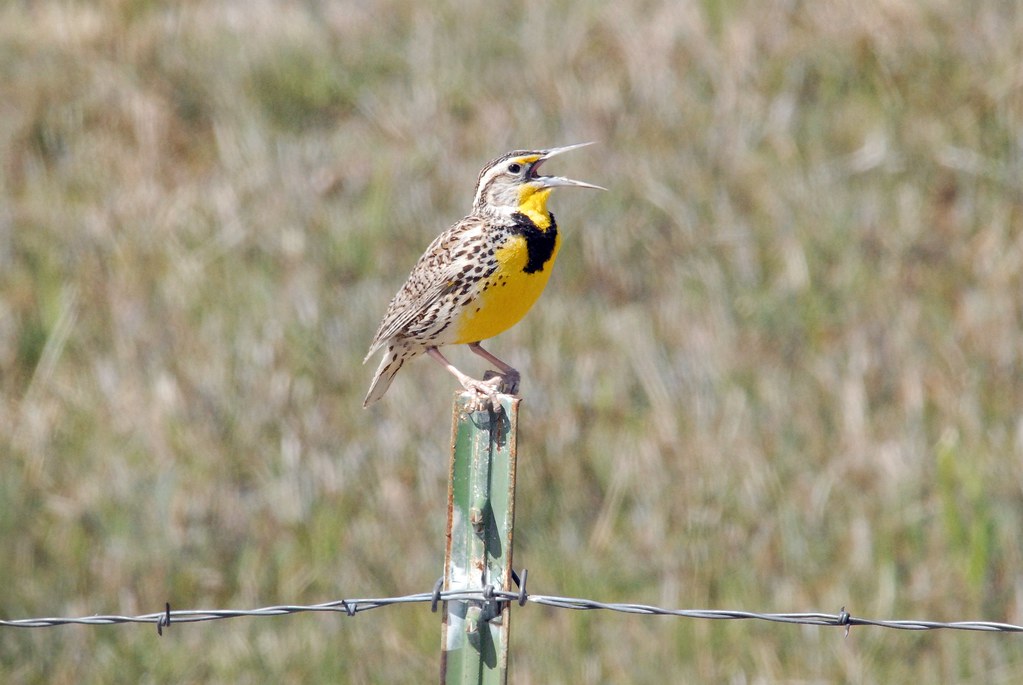
Western Meadowlark (Sturnella neglec), Malheur National Wildlife Refuge, Oregon.An abundant and familiar bird of open country across the western two-thirds of the continent, the Western Meadowlark is known for its melodic song. It is frequently seen singing along roadsides in native grassland and agricultural areas. Meadowlarks are common along roadsides nearMalheur National Wildlife Refuge in southeast Oregon.: photo by Dan Dzurisin, 15 April 2007
Image may be NSFW.
Clik here to view.
White-faced Ibis (Plegadis chihi), Malheur National Wildlife Refuge, Oregon. The White-faced Ibis, a dark wading bird with a long, down-curved bill, breeds across the western United States northward to Montana, eastward to western Louisiana, and southward to South America. Ibis and other shore birds are numerous during spring migrations at Malheur National Wildlife Refuge in southeast Oregon.: photo by Dan Dzurisin, 15 April 2007
Clik here to view.

White-faced Ibis (Plegadis chihi), Malheur National Wildlife Refuge, Oregon. The White-faced Ibis, a dark wading bird with a long, down-curved bill, breeds across the western United States northward to Montana, eastward to western Louisiana, and southward to South America. Ibis and other shore birds are numerous during spring migrations at Malheur National Wildlife Refuge in southeast Oregon.: photo by Dan Dzurisin, 15 April 2007
Image may be NSFW.
Clik here to view.
Clik here to view.
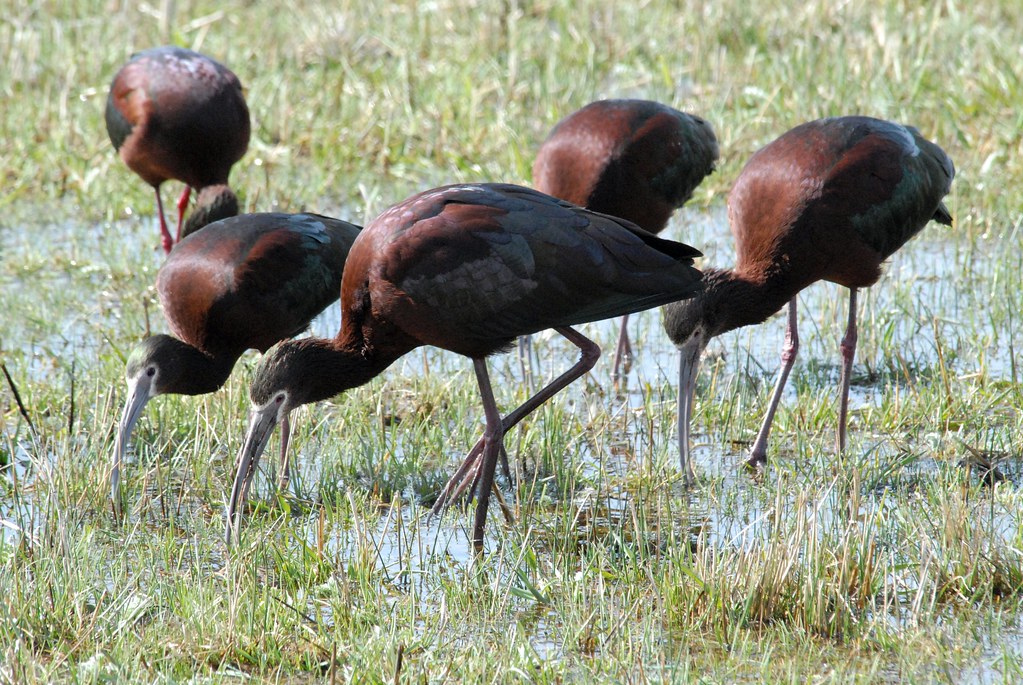
White-faced Ibis (Plegadis chihi), Malheur National Wildlife Refuge, Oregon. The White-faced Ibis, a dark wading bird with a long, down-curved bill, breeds across the western United States northward to Montana, eastward to western Louisiana, and southward to South America. Ibis and other shore birds are numerous during spring migrations at Malheur National Wildlife Refuge in southeast Oregon.: photo by Dan Dzurisin, 15 April 2007
Image may be NSFW.
Clik here to view.
Clik here to view.

Long-billed Curlew, Malheur National Wildlife Refuge, Oregon.North America's largest shore bird, the Long-billed Curlew breeds in the grasslands of the Great Plains and Great Basin. Curlews and other shore birds are numerous during spring migrations at Malheur National Wildlife Refuge in southeast Oregon.: photo by Dan Dzurisin, 15 April 2007
Image may be NSFW.
Clik here to view.
Clik here to view.
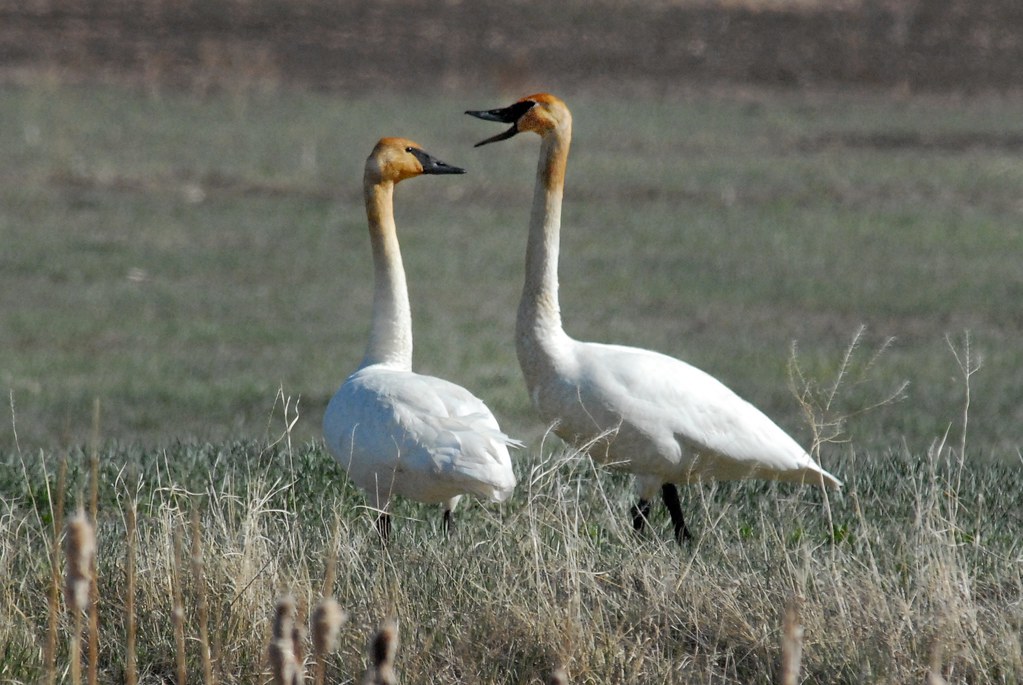
Tundra Swans (Cygnus columbianus), Malheur National Wildlife Refuge, Oregon. True to its name, the Tundra Swan breeds in the high tundra across the top of North America. It winters in large flocks across both coasts, and is frequently encountered during its migration across the continent, This pair was photographed in the southern part of Malheur National Wildlife Refuge in April 2007.: photo by Dan Dzurisin, 15 April 2007
Image may be NSFW.
Clik here to view.![American Avocet (Recurvirostra americana) DSC_0023 | by NDomer73]()
Clik here to view.
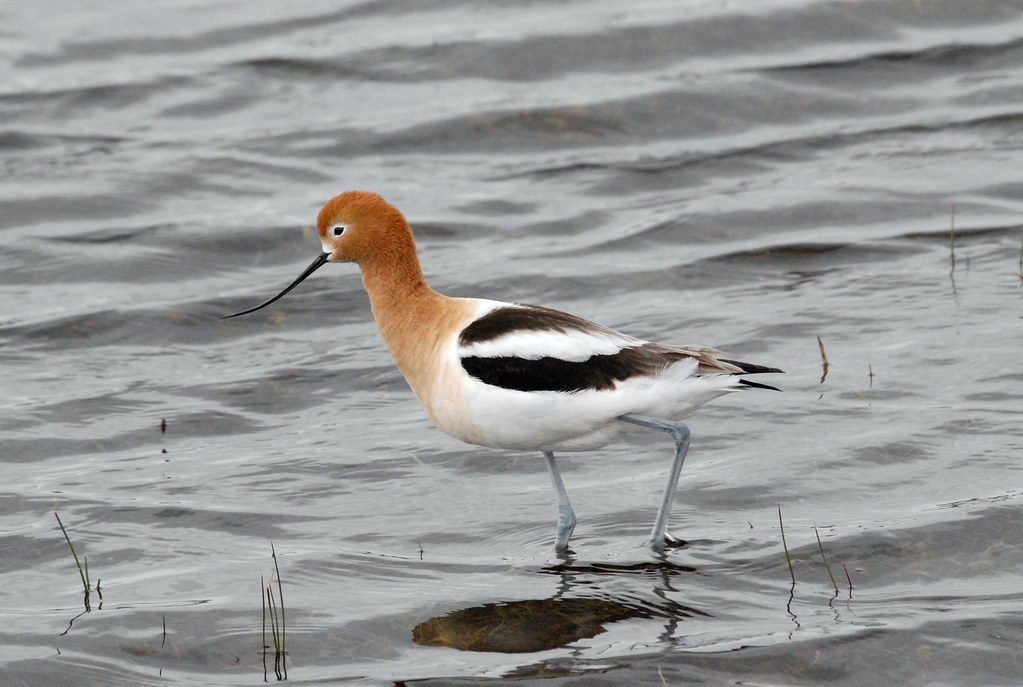
American Avocet (Recurvirostra americana), Malheur National Wildlife Refuge, Oregon. With its elegant profile and striking coloration, the American Avocet is unique among North American birds. In summer it can be found in temporary and unpredictable wetlands across western North America, where it swings its long upturned bill through shallow water to catch small invertebrates.: photo by Dan Dzurisin, 15 April 2007
Image may be NSFW.
Clik here to view.![Ross' Geese (Chen rossii) DSC_0184 | by NDomer73]()
Clik here to view.
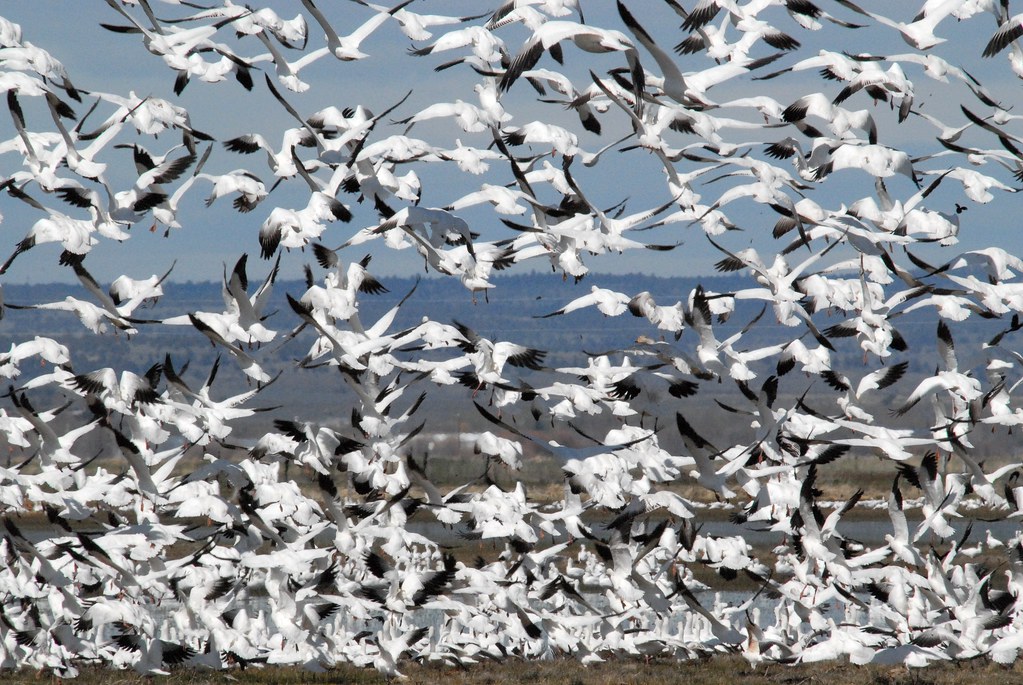
Ross' Geese (Chen rossii), Malheur National Wildlife Refuge, Oregon. A tiny white goose with black wingtips, the Ross' Goose is like a miniature version of the more abundant Snow Goose. The Ross' Goose breeds in the central Arctic and winters in central California. During spring migration, thousands ofRoss' Geese transit Malheur National Wildlife Refuge and flooded agricultural fields nearby.: photo by Dan Dzurisin, 15 April 2007
in a lake risen from a volcano
Indonesia’s Mount Sinabung volcano spews lava and ash during an eruption as it is seen from Tiga Pancur village in Karo, North Sumatra province: photo by Rony Muharrman/Reuters, 8 January 2016
Joseph Ceravolo: March 7, 1988
Swamps and people live in a lake
risen from a volcano
An island bolted from fire
appears out of the sea like
A memory appearing in the shadow
of dark yearnings.
Who can appear to me?
Joseph Ceravolo (1934-1988): March 7, 1988, from Collected Poems, 2012
Ekrem Turkmen poses for a portrait in his store selling Ottoman Traditional clothing inside the Istanbul Grand Bazaar in Istanbul, Turkey. Istanbul’s Grand Bazaar is one of the oldest covered markets in the world and hosts more than 3,000 stores. It is estimated that more than 250,000 people visit the bazaar each day : photo by Chris McGrath via FT Photo Diary, 8 January 2016
Image may be NSFW.
Clik here to view.
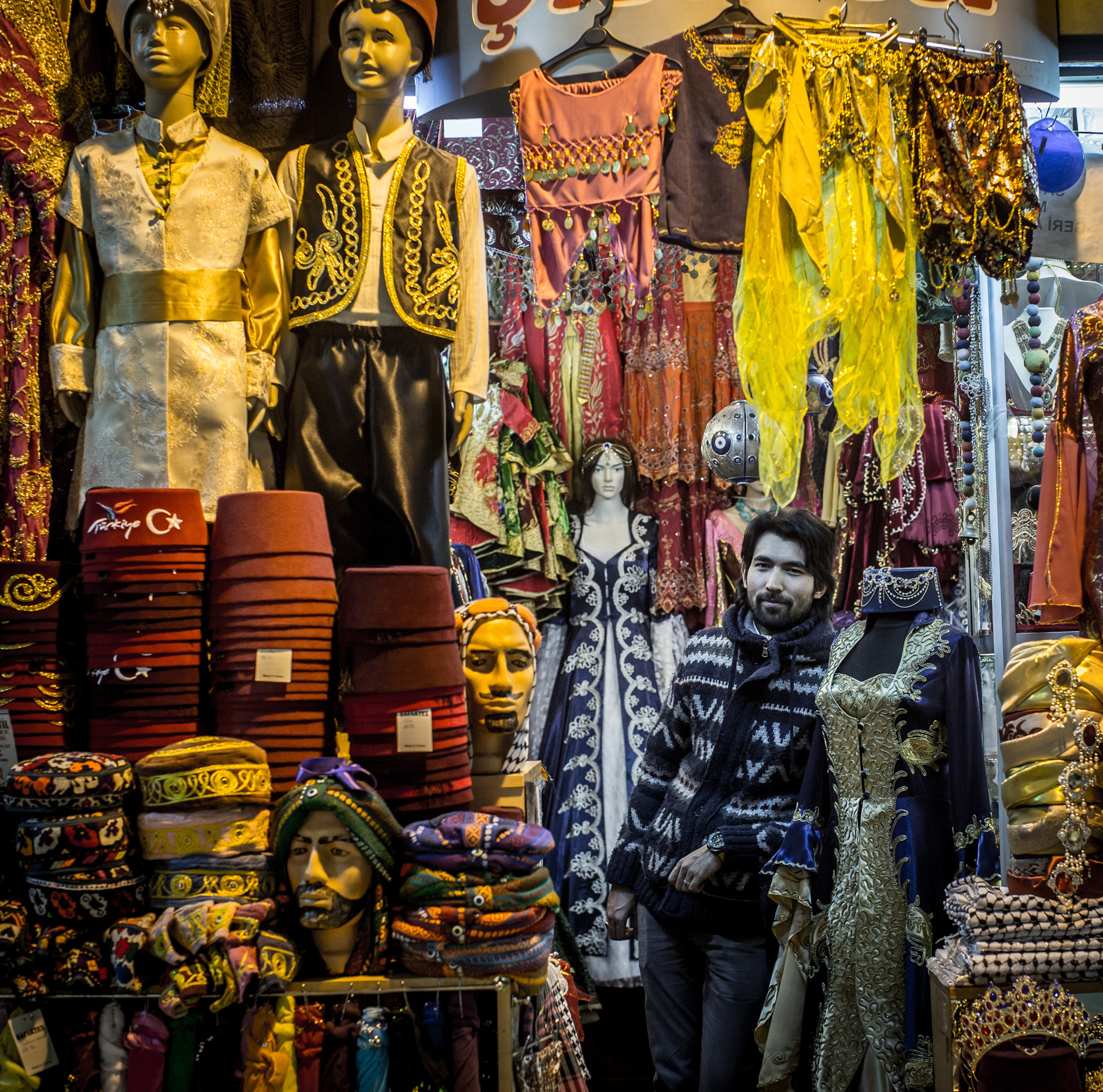
.
Ekrem Turkmen poses for a portrait in his store selling Ottoman Traditional clothing inside the Istanbul Grand Bazaar in Istanbul, Turkey. Istanbul’s Grand Bazaar is one of the oldest covered markets in the world and hosts more than 3,000 stores. It is estimated that more than 250,000 people visit the bazaar each day : photo by Chris McGrath via FT Photo Diary, 8 January 2015
in the hour of the street
A Palestinian protester walks past burning tyres during clashes with Israeli security forces following a demonstration against the expropriation of Palestinian land by Israel, on in the village of Kafr Qaddum: photo by Jaafar Ashtiyeh/AFP, 8 January 2015
All the stars will be gone,
there is enough emptiness in space
to absorb all dust of stars,
while you and I speak under voice
of birds, sleep, mist
at the hour of the street.
Nobody is loitering, O sensual eyes
just see or connect the dreamers
and as our generation's blood spills,
the water of night is flooding us.
Nobody's holding anybody's wrist
nobody's humming nobody's singing
in the hour of the street.
Joseph Ceravolo (1934-1988): January 1988, from Collected Poems, 2012
A Yemeni inspects a vehicle destroyed by airstrikes allegedly carried out by the Saudi-led coalition in Sana’a. Airstrikes by the Saudi-led coalition have intensified since the humanitarian ceasefire in Yemen ended: photo by Yahya Arhab/EPA, 8 January 2016
Image may be NSFW.
Clik here to view.

A Yemeni inspects a vehicle destroyed by airstrikes allegedly carried out by the Saudi-led coalition in Sana’a. Airstrikes by the Saudi-led coalition have intensified since the humanitarian ceasefire in Yemen ended: photo by Yahya Arhab/EPA, 8 January 2016
Migrants and refugees walk on Friday after crossing the Macedonian border in the Serbian village of Miratovac. Migrants and refugees are facing deteriorating weather conditions as they make their way to the EU via the Balkans: photo by Armend Nimani/AFP 8 January 2016
Image may be NSFW.
Clik here to view.
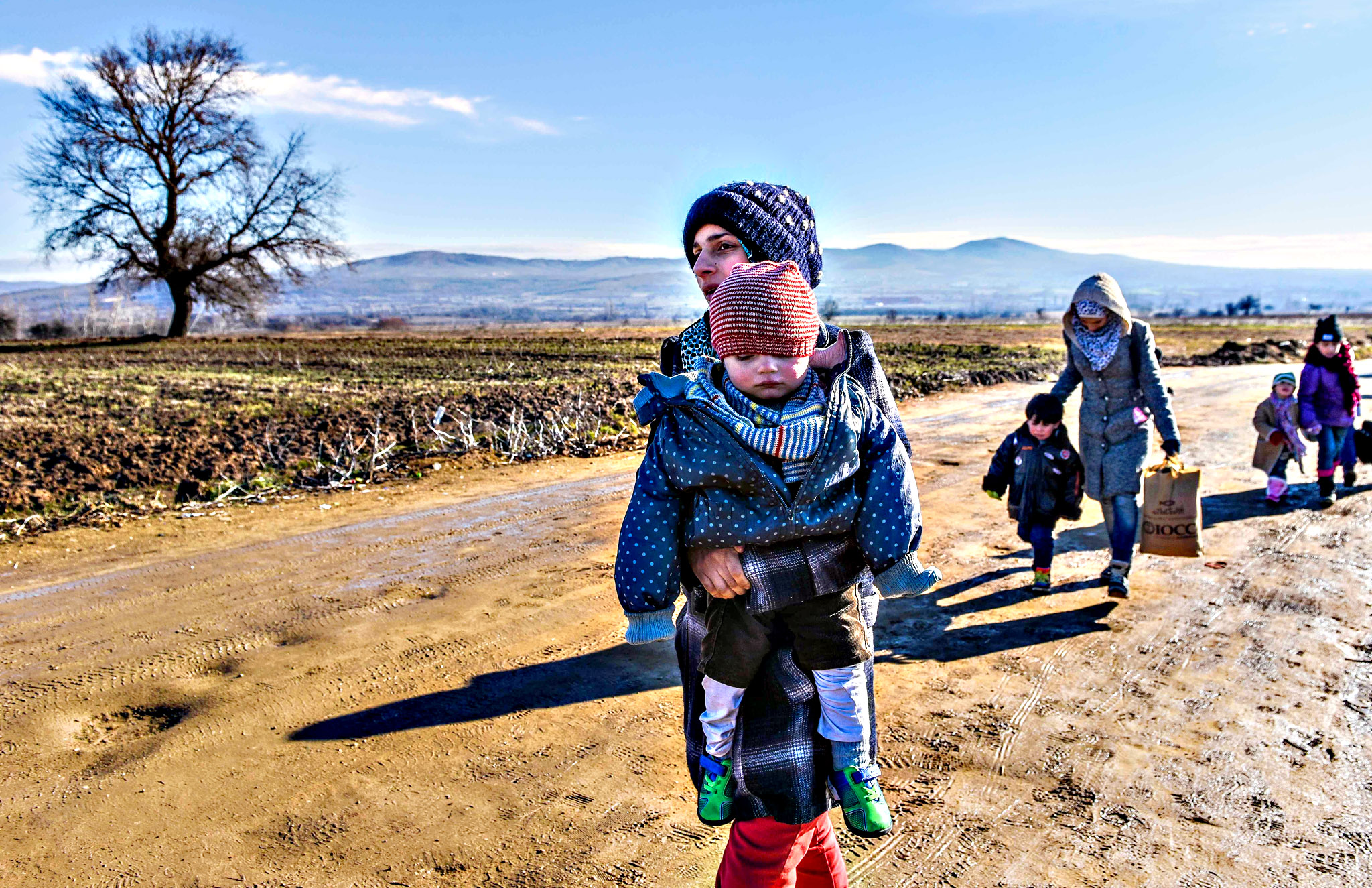
Migrants and refugees walk on Friday after crossing the Macedonian border in the Serbian village of Miratovac. Migrants and refugees are facing deteriorating weather conditions as they make their way to the EU via the Balkans: photo by Armend Nimani/AFP 8 January 2016
An Iranian woman holds up a poster showing Sheikh Nimr al-Nimr, a prominent opposition Saudi Shia cleric who was executed last week by Saudi Arabia, in Tehran, Iran: photo by Vahid Salemi/AP, 4 January 2016
Image may be NSFW.
Clik here to view.

An Iranian woman holds up a poster showing Sheikh Nimr al-Nimr, a prominent opposition Saudi Shia cleric who was executed last week by Saudi Arabia, in Tehran, Iran: photo by Vahid Salemi/AP, 4 January 2016
Shia Muslims shout slogans during a protest against the execution of cleric Nimr al-Nimr, who was executed along with others in Saudi Arabia, on the outskirts of Srinagar, India on Friday ended: photo by Danish Ismail/Reuters, 8 January 2016
Image may be NSFW.
Clik here to view.

Shia Muslims shout slogans during a protest against the execution of cleric Nimr al-Nimr, who was executed along with others in Saudi Arabia, on the outskirts of Srinagar, India on Friday ended: photo by Danish Ismail/Reuters, 8 January 2016
Image may be NSFW.
Clik here to view.![Iraqi forces secure an area near the Grand Mosque in central Ramadi, the capital of Iraq's Anbar province, on Friday, after retaking the city from Islamic State (IS) group jihadists]()
Clik here to view.

Iraqi forces secure an area near the Grand Mosque in central Ramadi, the capital of Iraq’s Anbar province, on Friday, after retaking the city from Islamic State (IS) group jihadists: photo by AFP, 8 January 2016
Image may be NSFW.
Clik here to view.![Iraqi forces secure an area near the Grand Mosque in central Ramadi, the capital of Iraq's Anbar province, on Friday, after retaking the city from Islamic State (IS) group jihadists]()
Iraqi forces secure an area near the Grand Mosque in central Ramadi, the capital of Iraq’s Anbar province, on Friday, after retaking the city from Islamic State (IS) group jihadists: photo by AFP, 8 January 2016
Image may be NSFW.
Clik here to view.

Iraqi forces secure an area near the Grand Mosque in central Ramadi, the capital of Iraq’s Anbar province, on Friday, after retaking the city from Islamic State (IS) group jihadists: photo by AFP, 8 January 2016
A customer asks for the price of a bittergourd at Duri market on a railway track in Jakarta, on Friday: photo by Beawiharta/Reuters, 8 January 2016
A customer asks for the price of a bittergourd at Duri market on a railway track in Jakarta, on Friday: photo by Beawiharta/Reuters, 8 January 2016
Supporters of U.S. Republican presidential candidate Donald Trump jeer at protesters during a campaign rally in Burlington, Vermont : photo by Erin Siegal/Reuters, 8 January 2016
Refuge
Image may be NSFW.
Clik here to view.![Greater Sage-Grouse (Centrocercus urophasianus) DSC_0070 | by NDomer73]()
Clik here to view.
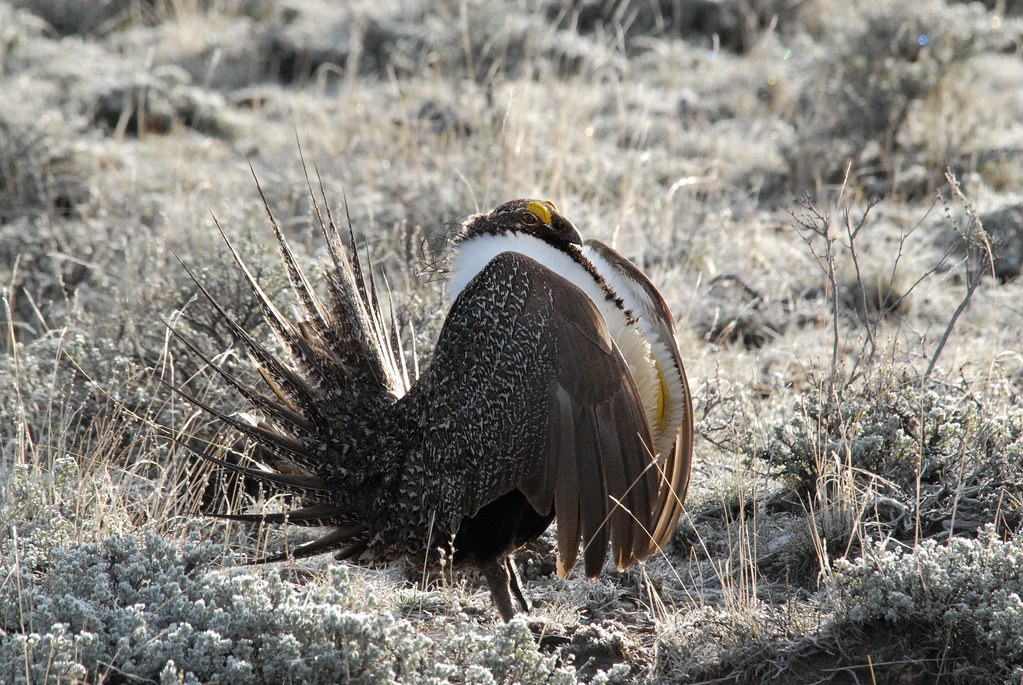
Greater Sage-Grouse (Centrocercus urophasianus), male, Malheur National Wildlife Refuge. A bird of the open sagebrush plains, the Greater Sage-Grouse is the largest grouse species in North America. As in many other grouse species, the male plays no role in the raising of the young. Males display on dancing grounds known as leks. Females visit the leks to mate, then go off to raise their brood by themselves. Traditional lekking grounds may be used for decades. Although many male Greater Sage-Grouse may display at a lek, only one or two males get picked by a majority of females for mating. We observed a lek with about 15 males displaying for two females on two consecutive mornings in April: photo by Dan Dzurisin, April 2007
Image may be NSFW.
Clik here to view.![Greater Sage-Grouse (Centrocercus urophasianus) DSC_0041 | by NDomer73]()
Greater Sage-Grouse (Centrocercus urophasianus), male, Malheur National Wildlife Refuge. A bird of the open sagebrush plains, the Greater Sage-Grouse is the largest grouse species in North America. As in many other grouse species, the male plays no role in the raising of the young. Males display on dancing grounds known as leks. Females visit the leks to mate, then go off to raise their brood by themselves. Traditional lekking grounds may be used for decades. Although many male Greater Sage-Grouse may display at a lek, only one or two males get picked by a majority of females for mating. We observed a lek with about 15 males displaying for two females on two consecutive mornings in April: photo by Dan Dzurisin, April 2007
Clik here to view.
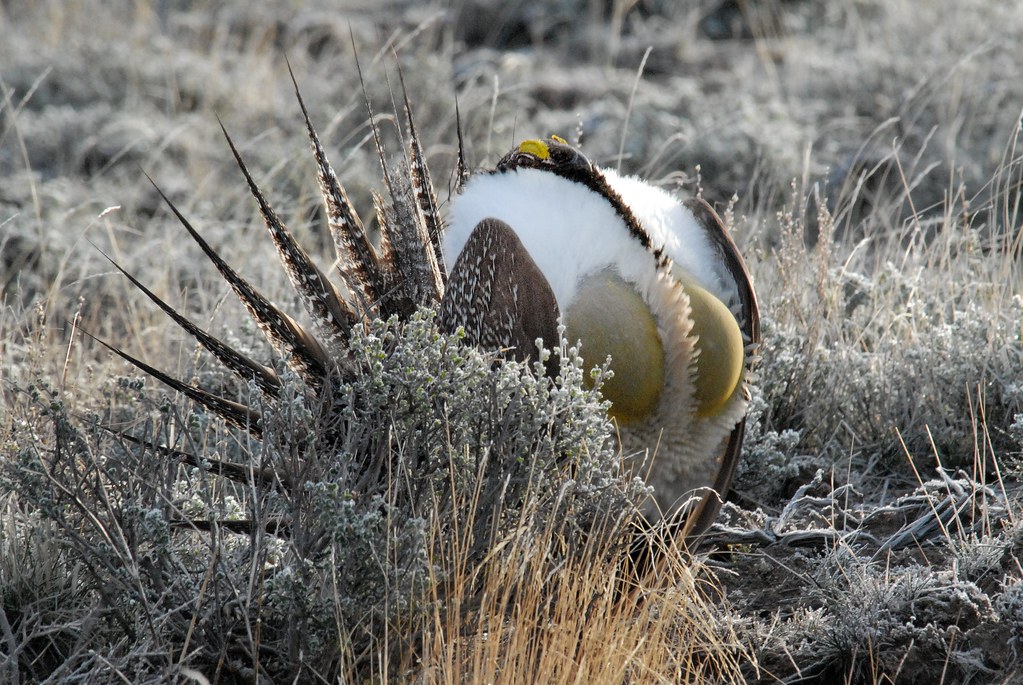
Greater Sage-Grouse (Centrocercus urophasianus), male, Malheur National Wildlife Refuge. A bird of the open sagebrush plains, the Greater Sage-Grouse is the largest grouse species in North America. As in many other grouse species, the male plays no role in the raising of the young. Males display on dancing grounds known as leks. Females visit the leks to mate, then go off to raise their brood by themselves. Traditional lekking grounds may be used for decades. Although many male Greater Sage-Grouse may display at a lek, only one or two males get picked by a majority of females for mating. We observed a lek with about 15 males displaying for two females on two consecutive mornings in April: photo by Dan Dzurisin, April 2007
Image may be NSFW.
Clik here to view.![Greater Sage-Grouse (Centrocercus urophasianus) DSC_0153 | by NDomer73]()
Greater Sage-Grouse (Centrocercus urophasianus), male, Malheur National Wildlife Refuge. A bird of the open sagebrush plains, the Greater Sage-Grouse is the largest grouse species in North America. As in many other grouse species, the male plays no role in the raising of the young. Males display on dancing grounds known as leks. Females visit the leks to mate, then go off to raise their brood by themselves. Traditional lekking grounds may be used for decades. Although many male Greater Sage-Grouse may display at a lek, only one or two males get picked by a majority of females for mating. We observed a lek with about 15 males displaying for two females on two consecutive mornings in April: photo by Dan Dzurisin, April 2007
Clik here to view.
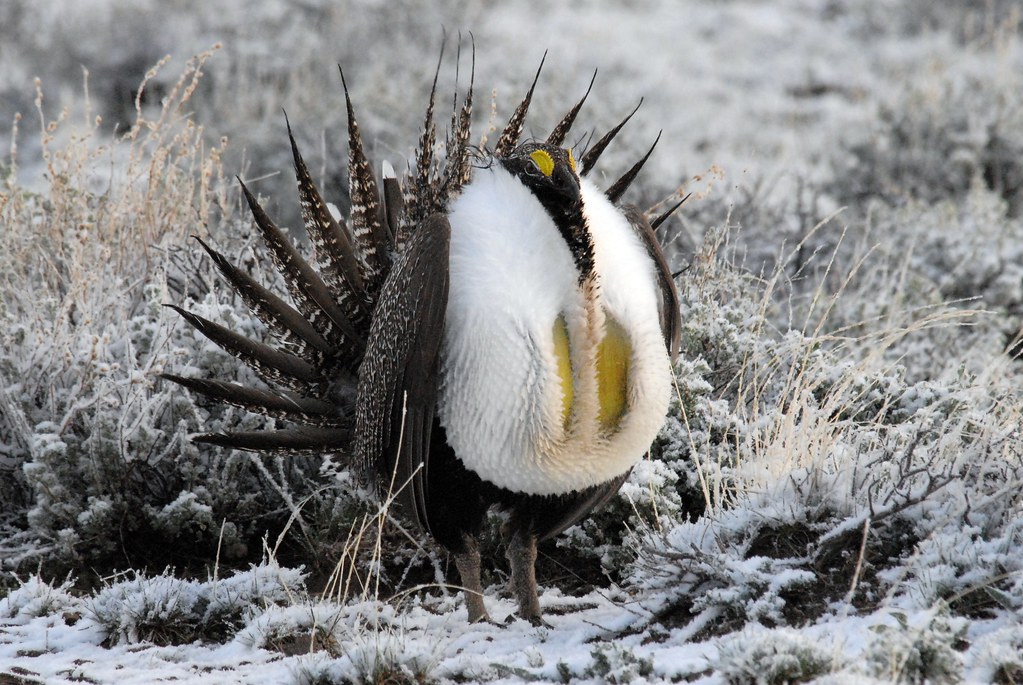
Greater Sage-Grouse (Centrocercus urophasianus), male, Malheur National Wildlife Refuge. A bird of the open sagebrush plains, the Greater Sage-Grouse is the largest grouse species in North America. As in many other grouse species, the male plays no role in the raising of the young. Males display on dancing grounds known as leks. Females visit the leks to mate, then go off to raise their brood by themselves. Traditional lekking grounds may be used for decades. Although many male Greater Sage-Grouse may display at a lek, only one or two males get picked by a majority of females for mating. We observed a lek with about 15 males displaying for two females on two consecutive mornings in April: photo by Dan Dzurisin, April 2007
Image may be NSFW.
Clik here to view.![Greater Sage-grouse (Centrocercus urophasianus) DSC_0054 | by NDomer73]()
Clik here to view.
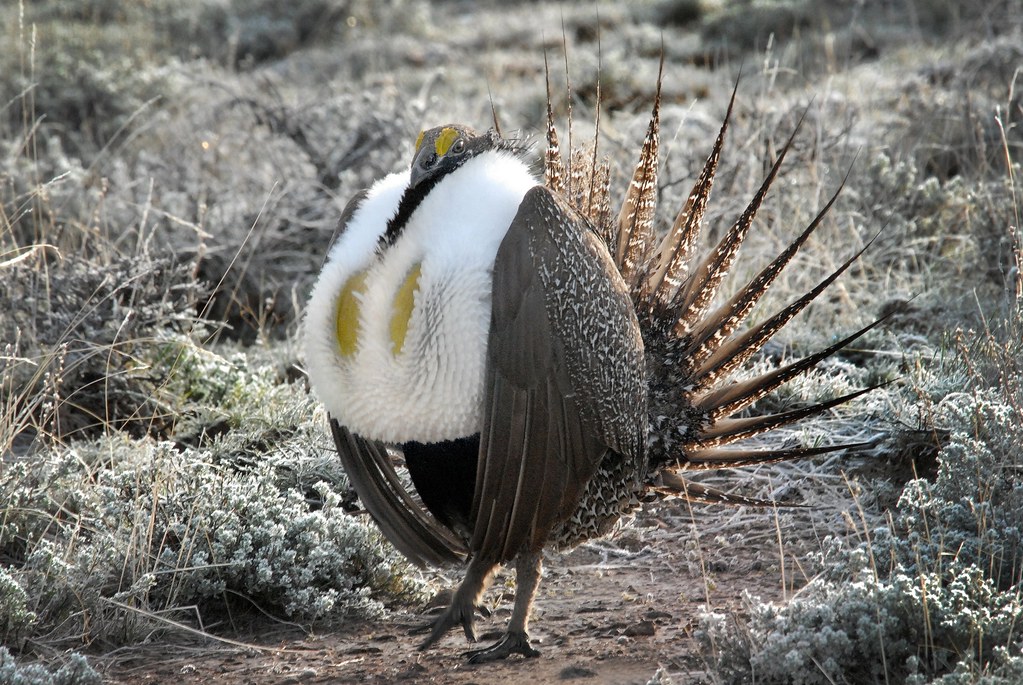
Greater Sage-Grouse (Centrocercus urophasianus), male, Malheur National Wildlife Refuge. A bird of the open sagebrush plains, the Greater Sage-Grouse is the largest grouse species in North America. As in many other grouse species, the male plays no role in the raising of the young. Males display on dancing grounds known as leks. Females visit the leks to mate, then go off to raise their brood by themselves. Traditional lekking grounds may be used for decades. Although many male Greater Sage-Grouse may display at a lek, only one or two males get picked by a majority of females for mating. We observed a lek with about 15 males displaying for two females on two consecutive mornings in April: photo by Dan Dzurisin, April 2007
Image may be NSFW.
Clik here to view.![Greater Sage-Grouse (Centrocercus urophasianus) DSC_0147 | by NDomer73]()
Greater Sage-Grouse (Centrocercus urophasianus), male, Malheur National Wildlife Refuge. A bird of the open sagebrush plains, the Greater Sage-Grouse is the largest grouse species in North America. As in many other grouse species, the male plays no role in the raising of the young. Males display on dancing grounds known as leks. Females visit the leks to mate, then go off to raise their brood by themselves. Traditional lekking grounds may be used for decades. Although many male Greater Sage-Grouse may display at a lek, only one or two males get picked by a majority of females for mating. We observed a lek with about 15 males displaying for two females on two consecutive mornings in April: photo by Dan Dzurisin, April 2007
Clik here to view.
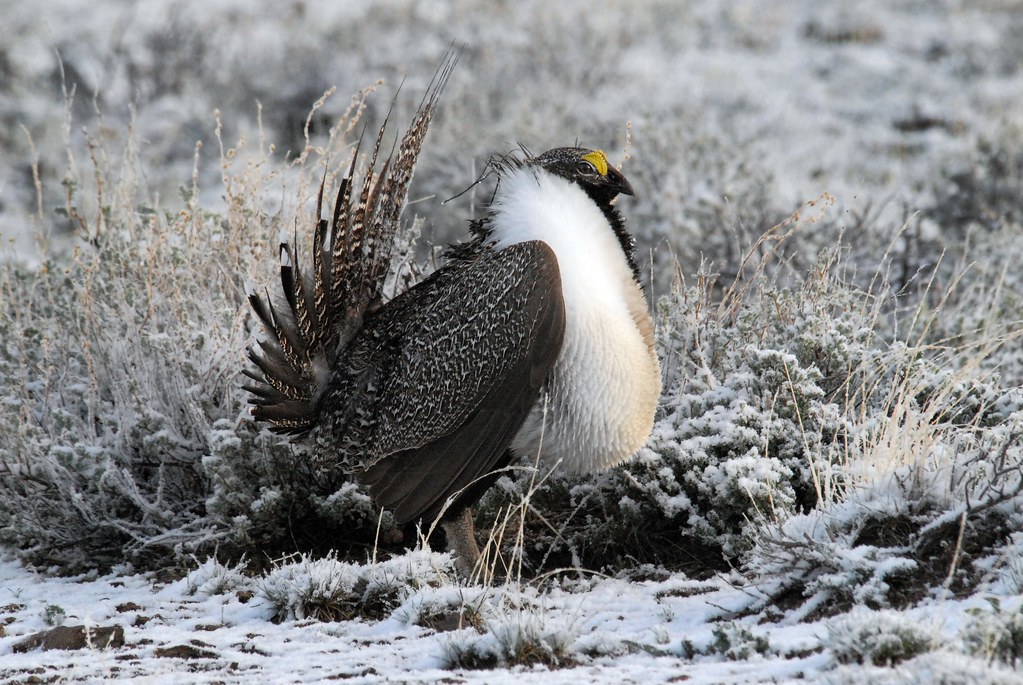
Greater Sage-Grouse (Centrocercus urophasianus), male, Malheur National Wildlife Refuge. A bird of the open sagebrush plains, the Greater Sage-Grouse is the largest grouse species in North America. As in many other grouse species, the male plays no role in the raising of the young. Males display on dancing grounds known as leks. Females visit the leks to mate, then go off to raise their brood by themselves. Traditional lekking grounds may be used for decades. Although many male Greater Sage-Grouse may display at a lek, only one or two males get picked by a majority of females for mating. We observed a lek with about 15 males displaying for two females on two consecutive mornings in April: photo by Dan Dzurisin, April 2007
Image may be NSFW.
Clik here to view.![Greater Sage-Grouse (Centrocercus urophasianus) DSC_0122 | by NDomer73]()
Greater Sage-Grouse (Centrocercus urophasianus), male, Malheur National Wildlife Refuge. A bird of the open sagebrush plains, the Greater Sage-Grouse is the largest grouse species in North America. As in many other grouse species, the male plays no role in the raising of the young. Males display on dancing grounds known as leks. Females visit the leks to mate, then go off to raise their brood by themselves. Traditional lekking grounds may be used for decades. Although many male Greater Sage-Grouse may display at a lek, only one or two males get picked by a majority of females for mating. We observed a lek with about 15 males displaying for two females on two consecutive mornings in April: photo by Dan Dzurisin, April 2007
Greater Sage-Grouse (Centrocercus urophasianus), male, Malheur National Wildlife Refuge. A bird of the open sagebrush plains, the Greater Sage-Grouse is the largest grouse species in North America. As in many other grouse species, the male plays no role in the raising of the young. Males display on dancing grounds known as leks. Females visit the leks to mate, then go off to raise their brood by themselves. Traditional lekking grounds may be used for decades. Although many male Greater Sage-Grouse may display at a lek, only one or two males get picked by a majority of females for mating. We observed a lek with about 15 males displaying for two females on two consecutive mornings in April: photo by Dan Dzurisin, April 2007
Clik here to view.
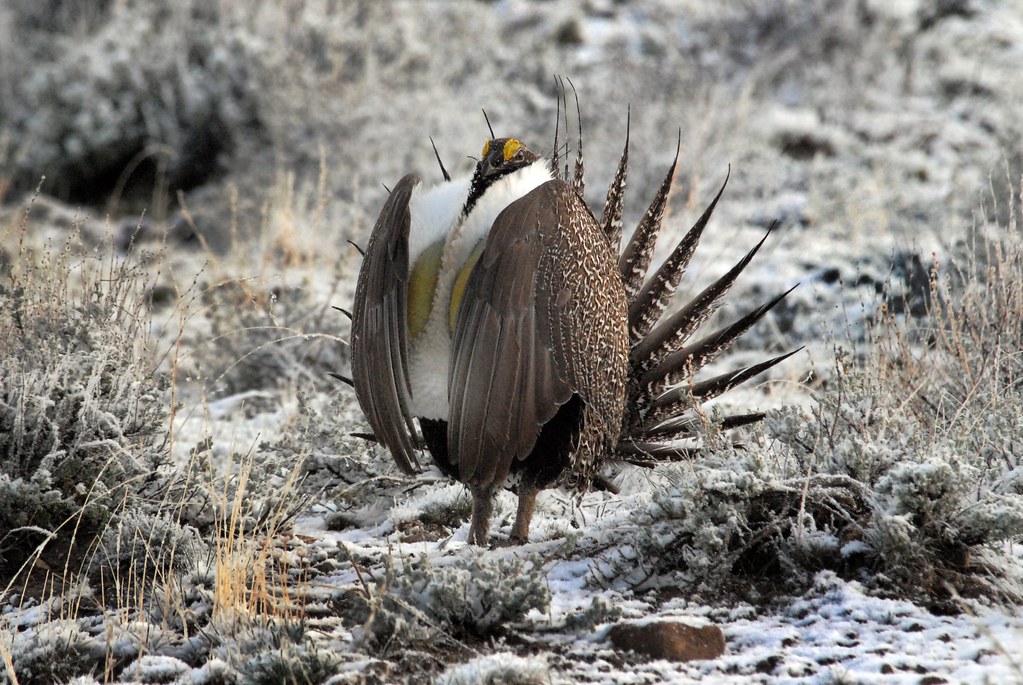
Greater Sage-Grouse (Centrocercus urophasianus), male, Malheur National Wildlife Refuge. A bird of the open sagebrush plains, the Greater Sage-Grouse is the largest grouse species in North America. As in many other grouse species, the male plays no role in the raising of the young. Males display on dancing grounds known as leks. Females visit the leks to mate, then go off to raise their brood by themselves. Traditional lekking grounds may be used for decades. Although many male Greater Sage-Grouse may display at a lek, only one or two males get picked by a majority of females for mating. We observed a lek with about 15 males displaying for two females on two consecutive mornings in April: photo by Dan Dzurisin, April 2007
Image may be NSFW.
Clik here to view.![Greater Sage-Grouse (Centrocercus urophasianus) DSC_0143 | by NDomer73]()
Clik here to view.
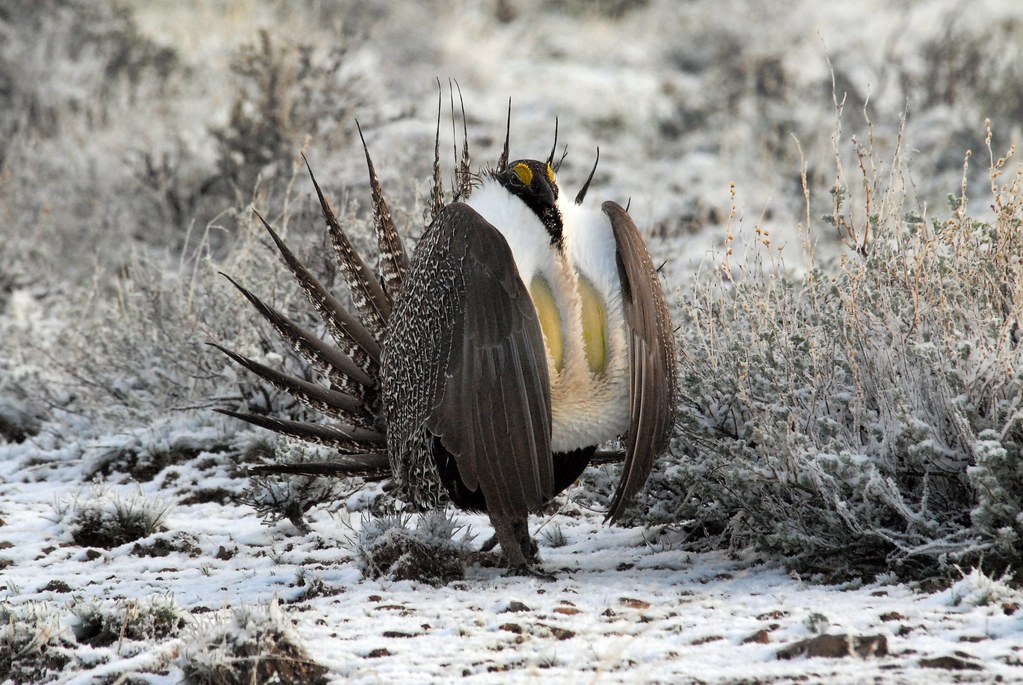
Greater Sage-Grouse (Centrocercus urophasianus), male, Malheur National Wildlife Refuge. A bird of the open sagebrush plains, the Greater Sage-Grouse is the largest grouse species in North America. As in many other grouse species, the male plays no role in the raising of the young. Males display on dancing grounds known as leks. Females visit the leks to mate, then go off to raise their brood by themselves. Traditional lekking grounds may be used for decades. Although many male Greater Sage-Grouse may display at a lek, only one or two males get picked by a majority of females for mating. We observed a lek with about 15 males displaying for two females on two consecutive mornings in April: photo by Dan Dzurisin, April 2007
Image may be NSFW.
Clik here to view.![donner_blitzen_river | by Oregon Department of Fish & Wildlife]()
Clik here to view.
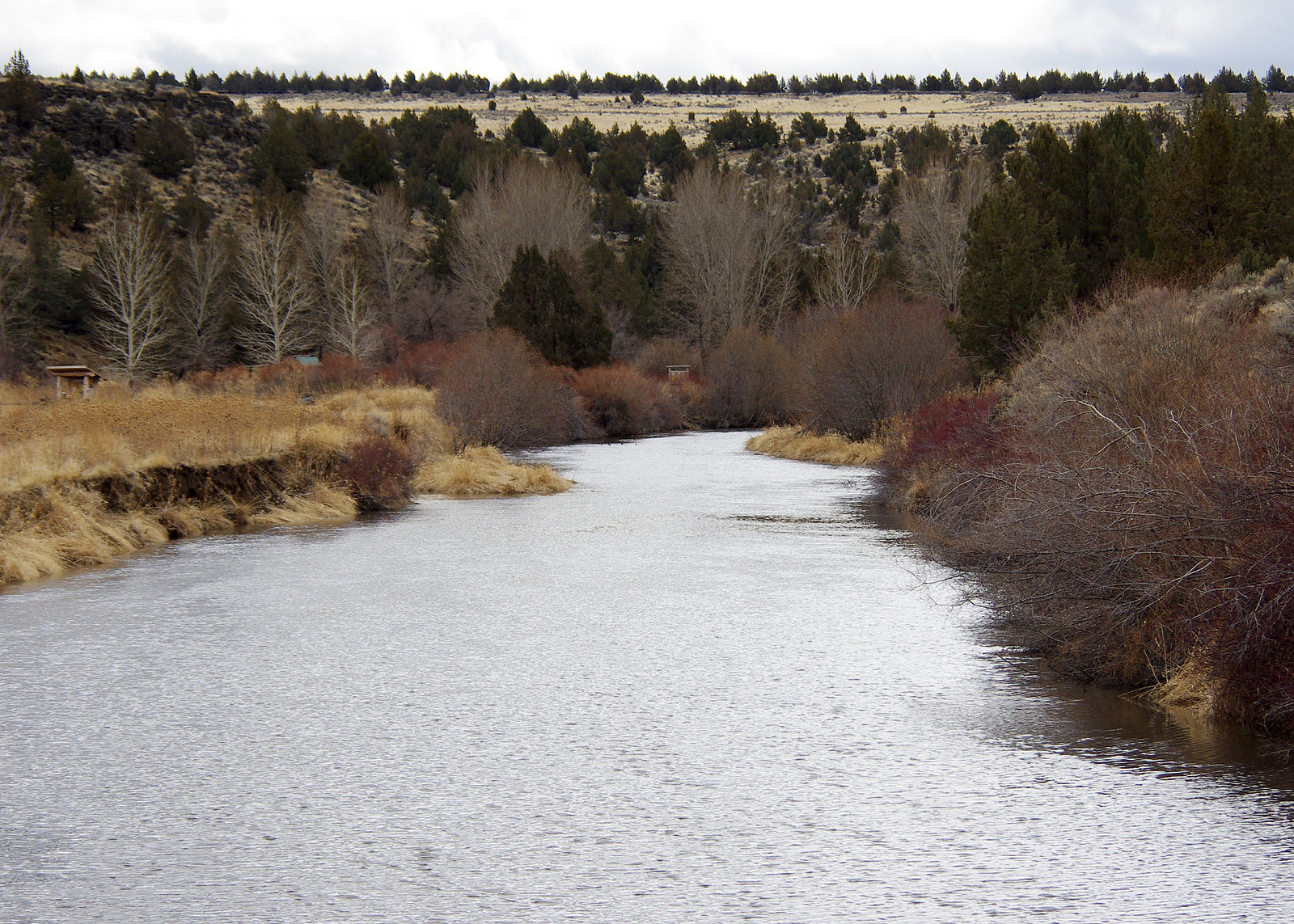
The Donner and Blitzen River in the Oregon high desert drains the southern portion of Harney Basin, from roughly 20 to 80 miles south-southeast of Burns including the Malheur National Wildlife Refuge: photo by Martyne Reesman, Oregon Department of Fish and Wildlife, 15 March 2012
Image may be NSFW.
Clik here to view.![Embedded image permalink]()
Clik here to view.

DEVELOPING: #AmmonBundy militia takeover sparked by Hammonds’ “unconstitutional” sentencing: image via RT Verified account @RT_com, 2 January 2015
What will happen if the Oregon militia gets its demands? Kate Galbraith in San Francisco and Sarah Gilman in Portland for The Guardian, 8 January 2016
Allowing cattle to graze across swathes of federal land in Oregon, as an armed band of militia is demanding, could have devastating consequences for the area’s delicate ecosystem, experts have warned.
Rare species such as the greater sage grouse that does a mating dance on federal land adjacent to the Malheur national wildlife refuge, occupied by the militia, have already been harmed by widespread cattle grazing on high-desert plains across the west.
The armed militia is occupying federal land in Oregon that contains swathes of marshland, an unusual feature amid the high desert of southeastern Oregon.
It offers protection for waterfowl across its 188,000 acres, an area nearly half the size of the sprawling city of Los Angeles.
The militia, a ragtag group whose leader, Ammon Bundy, comes from a Nevada family with a history of defying federal land-use rules, has a hazy wish list that includes the release of two Oregon men, imprisoned and convicted of arson. But one of their broadest demands is to transfer more federal land to private ownership in the area.
Such a change could mean a “scorched-earth” situation for wildlife, said Dale Goble, a professor and land-use expert at the University of Idaho’s College of Law, who had gone birding in the refuge.
“If you’ve driven through the high desert of eastern Oregon, the distinction between private and federal [land] is often strikingly clear,” he said. Were the land to be transferred to private ownership, “the marshes and everything that attracts the migratory bird species -- probably, my guess would be, used for irrigation”.
Image may be NSFW.
Clik here to view.![]()
Clik here to view.
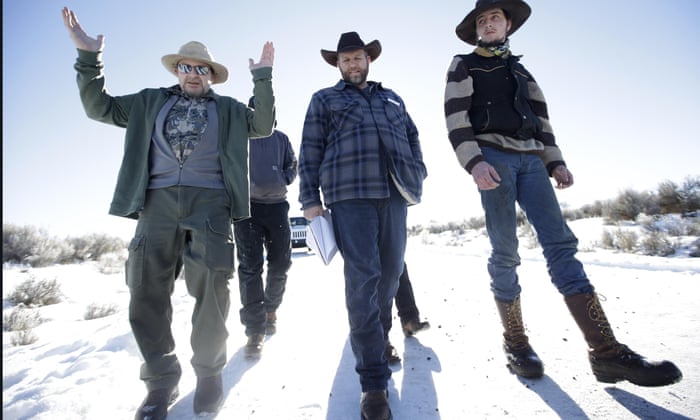
The armed militia are occupying federal land in Oregon that contains swathes marshland, an unusual feature amid the high desert of southeastern Oregon: photo by Rick Bowmer/AP, 8 January 2016
The federal Fish and Wildlife Service, which oversees federal endangered and threatened species, manages the Oregon refuge. Another agency called the Bureau of Land Management is also in the Oregon militia’s sights; it manages enormous western tracts and is the largest landowner in the United States.
In the mid-to-late 20th century, ranchers and other groups began a movement known as the Sagebrush Rebellion to lobby for more federal land to be transferred to state control. That effort continues today, Goble said, in states like Utah and Idaho.
The modern-day rebels have an even more radical wish: to transfer federal lands to private control. How that would happen is unclear, and ordinary ranchers may not have enough money to buy the land in any case, Goble said.
But increased private ownership could have harsh consequences for wildlife across the west, where many plants and animals are already on the federal government’s list of threatened or endangered species.
Dan Morse of the Oregon Natural Desert Association, an environmental group, said that while some species can get by with a network of connected public lands, it’s much harder to protect them when the land is a patchwork of private owners who manage their property mainly for economic gain.
“For me, one of the most concerning notions is the concept that these lands need to be returned to the public,” Morse says. The land, and its benefits, “already are public.”
In Oregon, waves of songbirds, sandhill cranes, long-billed curlews and other waterfowl pass through Malheur, which is a “crown jewel” of the federal refuge system, says Bob Sallinger, conservation director of the Portland Audubon Society. Some 20% of the entire population of white-faced ibises use the refuge’s lakes and waterways, he added.
“Any forage, any grass, any wildflower that cows eat isn’t available for bighorn sheep, deer, elk, pronghorn, sage grouse, butterflies or other native wildlife species,” says Andy Kerr, an environmental consultant who worked on conservation and public land grazing issues near the refuge in the 1990s.
“Twenty percent of all species listed under the Endangered Species Act have livestock as a factor in their decline.”
Image may be NSFW.
Clik here to view.

Rare species such as the greater sage grouse that do a mating dance on federal land adjacent to the Malheur national wildlife refuge, occupied by the militia, have already been harmed by widespread cattle grazing on high-desert plains across the west: photo by Jerret Raffety/AP, 8 January 2016
The Borax Lake chub, an endangered species of fish, is found largely in the Oregon county that contains the refuge.
The federal government’s record on environmental management is far from perfect, but it is considerably better than that of private landowners, Goble said. The US Fish and Wildlife Service, the agency that oversees the refuge, has a clear responsibility to manage its refuges for the sake of wildlife. The service also oversees endangered or threatened species listings, so it has a direct responsibility to protect them.
The Bureau of Land Management, which oversees some 260m acres across the United States, has a less clear-cut connection to threatened wildlife. It has sometimes been known as the “Bureau of Livestock and Mining” because it allows private companies and individuals to use its land for grazing (for a low fee), logging and other extraction activities.
Cliven Bundy, a Nevada rancher and the father of Ammon, led an armed dispute against federal agents last year after he grazed his cattle on BLM land without paying.
The BLM must consult with the wildlife service over endangered or threatened species on its lands, which should ensure at least some protections. Private landowners do not have to do such consultations, though they are prohibited from killing (or contributing to the killing of) endangered species on their property.
Ranchers across the west have a different view: They see themselves as the best stewards of the land, and the federal government as imposing onerous requirements.
Erin Maupin, a rancher near the refuge who visited the occupation this week, said government wildlife officials had no business controlling the land and have done a poor job of caring for the local environment. “More birds come to our ranches than here,” she said.
“Non-use is misuse,” she said. “We need to play an active role in managing this land. What’s best for the species is not to do nothing.”
Image may be NSFW.
Clik here to view.![]()
Clik here to view.
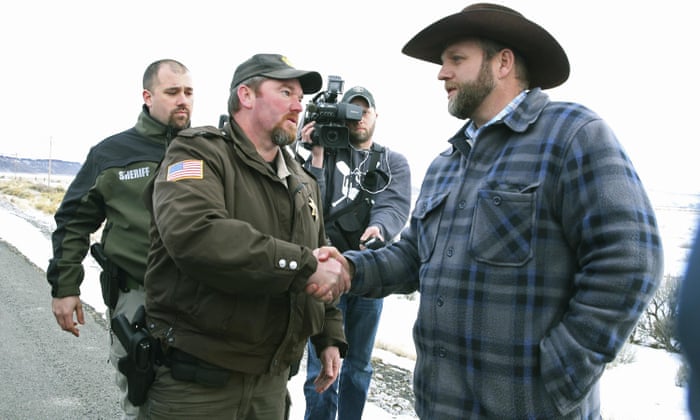
Harney County sheriff Dave Ward meets with Ammon Bundy outside the wildlife refuge: photo by Beth Nakamura/AP, 6 January 2015
Image may be NSFW.
Clik here to view.![img117 Double-crested Cormorant Nestlings | by Jon. D. Anderson]()
Clik here to view.
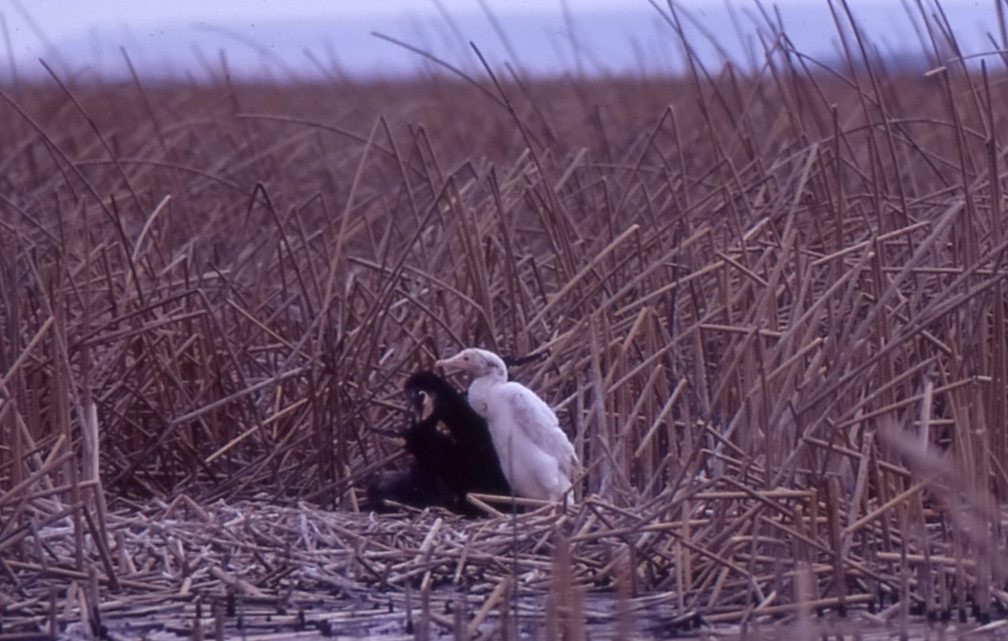
Albino Dark-crested Cormorant (Phelacrocorax auritus) nestlings, Malheur Lake, Malheur National Wildlife Refuge, Oregon: photo by Jon C. Anderson, 16 May 1972
Image may be NSFW.
Clik here to view.![]()
Clik here to view.

Blackbird, Burns, Oregon: photo by Austin Granger, 22 April 2014
